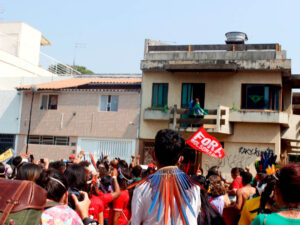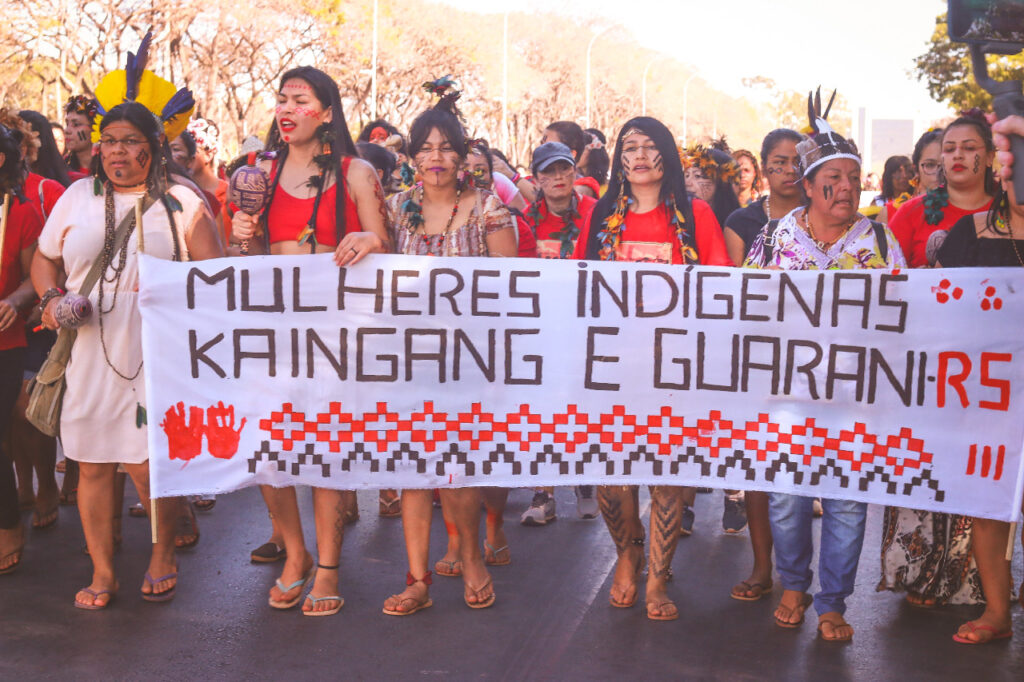Indigenous Women’s March in defense of land and natural resources in Brazil

Highlighting MERE Hub Brazil
Led by Indigenous women, Indigenous people mobilized in 2021 to counter governmental attempts to further dispossess and displace them of their lands and territories. The Brazilian government is seeking to open large areas to both domestic and foreign investment for the purposes of large-scale resource extraction. Indigenous people responded by demonstrating their disapproval of the government’s intentions through virtual and in-person collective actions.
In 2021, KAIROS launched the Brazil phase of Mother Earth and Resource Extraction: Women Defending Land and Water (MERE Hub, for short). MERE Hub is a living digital hub on the gendered impacts of resource extraction created for and in consultation with women land and water defenders. Sônia Guajarara of Brazil’s Articulation of Indigenous Peoples (APIB) and Maria Júlia Andrade of the Movement for Popular Sovereignty (MAM) both spoke at the virtual launch of the Brazilian phase of MERE Hub. During the launch, they, too, expressed concern over the ongoing situation and its implications for human rights and ecological justice.
The essay below provides further context on the various strategies Indigenous people devised to assert their self-determination and address the pandemic in 2021. Fabricio Télo, one of the authors of the essay, led the effort to translate MERE Hub into Portuguese to ensure land and water defenders in Brazil have access to information and tools. Fernanda Kaingáng and Janaína Betto are also authors.
Fabricio Teló
Sociology Faculty, Kwantlen Polytechnic University, Canada
Fernanda Kaingáng
Indigenous Lawyer, Master of Laws (LL.M.) from the University of Brasília and PhD Candidate, Leiden University, Netherlands
Janaína Betto
PhD Candidate, Federal University of Santa Maria, Brazil
The “Marco Temporal” Thesis
The year 2021 in Brazil was marked by one of the largest Indigenous mobilizations in history. The trial in the Supreme Court on the so-called “Marco Temporal” (“Milestone” or “Time Limit Trick”), defended by the agribusiness sector, was the trigger that generated Indigenous engagement.
The “Marco Temporal” thesis is an interpretation of the Constitution, according to which Indigenous peoples would only be entitled to claim rights to certain territories if they were occupying that territory on October 5, 1988, the ratification date of the current Brazilian Constitution. The problem is that many Indigenous communities were forcibly displaced from their territories before 1988.
In 1889 Brazil turned from a monarchy to a republic. With the 1891 constitution transferring control of public lands from the federal government to the states, state governors understood that they were allowed to sell Indigenous lands to private buyers without restrictions, resulting in a significant increase in the violent expulsions of Indigenous communities.
In addition, a 1913 federal decree legitimized any land ownership that was formally declared. Anyone could go to court and claim ownership of a specific land swath. However, most peasants and Indigenous people did not have the opportunity to do so for the lands they occupied and were entitled to. Thus, the 1913 decree facilitated undue expropriations in the following years under the argument that they were not the legitimate occupants of the land. This set of policies made the beginning of the 20th century the peak period for the formation of latifundia in Brazil.
The creation of the “Indian Protection Service” (SPI) in 1910 to “protect” Indigenous people did not help either. On the contrary, due to the corruption of its officials, SPI acted in several situations on behalf of squatters of Indigenous lands. SPI officials issued false declarations attesting to the non-existence of Indigenous communities in territories where they were present in order to legitimize their expulsion. There are also reports of innumerable situations of torture, deaths, imprisonment, and enslavement of Indigenous people during the same period.
Later, the Vargas administration (1930-1945) promoted the occupation of the agricultural frontier, also known as the “march westward,” through which peasant families were settled on lands in the central-western part of the country, many of them Indigenous-inhabited lands. Then, during the military dictatorship of 1964-1985, a new wave of Indigenous expulsions occurred under the justification of “development” and “progress.”
The “Marco Temporal” thesis ignores this history of expulsions and proposes that Indigenous people would no longer have the right to the lands from which they were expelled throughout the 20th century. This erroneous interpretation of the Constitution would benefit agribusiness landowners interested in those same lands, many of which were illegally appropriated through land grabbing, a corrupt way of claiming ownership of land that was unduly appropriated.
The “Marco Temporal” thesis has been strengthened with the election of the current president Jair Bolsonaro, whose government opposes the recognition of Indigenous lands. The reduction in environmental inspection services and the weakening of the “Indian National Foundation” (Funai) resulting from Bolsonaro’s election have served as incentives for deforestation and the illegal occupation of Indigenous lands, whether for agricultural activities, mining, or simply real estate speculation.
Indigenous mobilizations
With over 1,200 Indigenous people in Brazil dead because of the COVID-19 pandemic, Brazil’s Articulation of Indigenous Peoples (APIB), alongside other Brazilian Indigenous organizations, began to use a strategy called “occupy the screens” to generate Indigenous mobilization using digital media. Indigenous women played a central role in the struggle for vaccines. Through the “Vacina Parente!” (“Vaccine Relative!”) campaign, they countered fake news about vaccines and encouraged vaccination among Indigenous peoples.

The advance of the various anti-Indigenous bills in Parliament forced Indigenous organizations to face the risks of catching COVID-19 and resume street mobilizations to confront what they call the “pandemic of hate.” Promoted by Brazil’s neoconservatism in alliance with the agribusiness sector, this other pandemic is considered by Indigenous organizations even more dangerous than COVID-19 itself.
In June 2021, APIB held the encampment “Levante Pela Terra” (Standing up for the Land). About 1,000 Indigenous people from 45 different regions of Brazil travelled to the Brazilian capital to oppose the “Marco Temporal” thesis and advocate for its ban by the Supreme Court. When camped in Brasilia, Indigenous representatives suffered offensives by the Military Police that intervened in a belligerent way, using tear gas and pepper spray. As the Supreme Court postponed the trial, Indigenous organizations intensified their mobilization with the “Fight for Life” campaign in August 2021 and the Second National March of Indigenous Women in September 2021.
The “Fight for Life” mobilization used the slogan “Our History Does Not Begin in 1988,” an allusion to the “Marco Temporal” thesis. The mobilization reached great proportions. It has been considered the largest Indigenous mobilization in the history of the country since the invasion of the Portuguese. More than 6,000 Indigenous representatives and several celebrities attended the rally. Nonetheless, the Supreme Court postponed once again the trial and part of the Indigenous activists decided to remain camped in Brasilia for a few more weeks.
The Indigenous Women March was led by the National Articulation of Indigenous Women Ancestral Warriors (ANMIGA), founded in 2021. With the leadership of women such as Sonia Guajajara, the march had over four thousand attendees from 185 different Nations. Using the slogan “Ancestral Women: Reforesting Minds for the Healing of the Earth,” the rally drew the attention of Brazil and the world to topics such as climate change, gender violence, and demarcation of Indigenous lands. Demarcation refers to the official recognition by the state that a certain territory belongs to a certain Indigenous Nation.
The Indigenous Women March took place simultaneously with pro-Bolsonaro demonstrations celebrating Brazil’s Independence Day (September 7). Similar to the “Truckers Convoy” in Canada, the far-right pro-Bolsonaro rallies featured racist speeches like “Brazil already has too much Indigenous land” and “we are already the country that preserves [the environment] the most.”
Indigenous women who attended the rally received threats from pro-Bolsonaro groups who claimed to want to “see indigenous blood spilled.” ANMIGA had to create an autonomous security team that worked day and night to guarantee their safety. A massive Indigenous Woman march was initially planned to take place on September 8 but had to be postponed twice due to threats from Bolsonaro-supporters attending the Independence Day rally and from ranchers who travelled to Brasília to accompany the Supreme Court trial on the “Marco Temporal” that had resumed on September 8.
After two days of postponing, on September 10, Indigenous women managed to take to the streets of Brasilia to show the strength of their struggle. They coloured the gray concrete of the Brazilian capital with their songs, dances, paintings, necklaces and headdresses, chanting “Bolsonaro get out,” “The word of the Indigenous woman is sacred,” and “The fight for mother earth is the mother of all fights.”
The initiatives of the Bolsonaro administration regarding Indigenous issues are similar to the practices adopted by colonial governments, thus undermining the principle of multiculturalism guaranteed in the 1988 Constitution, which had marked a new paradigm of relationship between the Brazilian State and Indigenous Peoples.
The “Reflorestarmentes” (Reforest Minds) Campaign
As scientists announce the arrival of the Anthropocene, we are reminded of some traditional Indigenous prophecies that foresee that humanity will experience a period of natural disasters. Climate change attests to the failure of capitalism and the flaws of the Fóg (i. e., white or non-Indigenous people in the Kaingáng language). For Indigenous peoples in Brazil, the world’s end began in 1500 when the Portuguese invaded their territories. Regardless of those who pretend that the planet can support ecocide and genocide, the effects of climate change will come for everyone.
In an attempt to make their voices listened to, Indigenous women in Brazil are calling on the international community to join the International Campaign “Reflorestarmentes,” to promote reforestation actions in Indigenous territories and a plan of mobilization to confront climate change and strengthen Indigenous territories. The campaign’s premise is that Indigenous peoples, as guardians of biodiversity, can help Western society rescue the “principle of full humanity,” an understanding of humanity that includes the respect for the rights of Indigenous peoples and mother Earth. For more information and how to join the struggle of Indigenous women in Brazil, access the campaign’s website: https://reflorestarmentes.org/.
